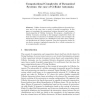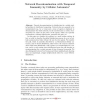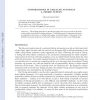1035 search results - page 4 / 207 » Communications in cellular automata |
IANDC
2008
13 years 7 months ago
2008
Abstract. Cellular Automata can be considered discrete dynamical systems and at the same time a model of parallel computation. In this paper we investigate the connections between ...
ACRI
2010
Springer
13 years 9 months ago
2010
Springer
Abstract. Network decontamination (or disinfection) is a widely studied problem in distributed computing. Network sites are assumed to be contaminated (e.g., by a virus) and a team...
RAS
2006
13 years 7 months ago
2006
Self-reconfigurable robots are built from modules, which are autonomously able to change the way they are connected. Such a robot can, through this self-reconfiguration process, c...
JAC
2008
13 years 9 months ago
2008
This reading guide aims to provide the reader with an easy access to the study of universality in the field of cellular automata. To fulfill this goal, the approach taken here is o...
SASO
2008
IEEE
14 years 2 months ago
2008
IEEE
—When programming a spatial computing medium such as a cellular automaton, the hop count distance to some set of sources (particles) is an often used information. In particular, ...



